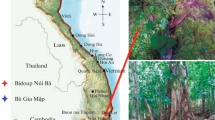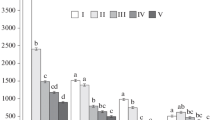Abstract
A rapid assessment on the status and distribution patterns of coarse woody debris (CWD) was conducted by laying five curvilinear transects (transects A, B, C, D and E; major trails), along an altitudinal gradient starting from 900 to 2 600 m, in three major watersheds (Charigad, Dogarhigad and upper Gosigad) of Goriganga catchment in Askot Wildlife Sanctuary, India. At every 100 m rise in altitude a hectare plot (100 m × 100 m) was selected. Results showed that the percentage contribution by different succession phases was in the decreasing order: phase I > phase II > phase IV > phase III for snags, and phase III > phase II > phase IV > phase I for logs. Snag density in chir pine forest was high in transect A (11 snags·ha−1) at 1 500 m, and the value in rianj oak forest was high in transect B (10 snags·ha−1) at 2 300 m. The total available mass of snags and logs in chir pine forest was 13.9 t, of which snags mass accounted for 41% of the total mass and logs mass for 59%. While the total value was 5.6 t in rianj oak forest, of which snags and logs accounted for 60% and 40% of the total mass, respectively. Moreover, the presence of CWD in the study area if not harvested, would provide a great opportunity to the orchids in future to flourish by providing protection. The high densities of snags and logs in chir pine forest at mid-altitudinal zone led to less species richness and lower density of ground flora as the zone receives more light, accompanying with lower soil moisture, and thus only the dominant species occupy the habitat.
Similar content being viewed by others
References
Adhikari BS, Rawat YS, Singh SP. 1995. Structure and function of high altitude forests in Central Himalaya. I. Dry Matter Dynamics. Annals of Botany, 75: 237–248.
Agee JK, Huff MH. 1987. Fuel succession in western hemlock/Douglas-fir forest. Can J For Res, 17: 697–704.
Auchmoody LR, Smith C. 1979. Oak soil-site relationships in northwestern West Virginia. Research Paper NE-434. US Department of Agriculture Forest Service, Northeast Forest Experiment Station, Broomall, PA, USA.
Baker TG, Attiwill PM. 1985. Above-ground nutrient distribution and cycling Pinus radiate and Eucalyptus oblique forest in southeastern Australia. For Ecol Manage, 13: 41–52.
Bebber DP, Cole WG, Thomas SC, Balsillie D, Duinker P. 2005. Effects of retention harvest on structure of old-growth Pinus strobes L. stand in Ontario. For Ecol Manage, 205: 91–103.
Busse MD. 1994. Downed bole-wood decomposition in lodgepole pine forests of central Oregon. Soil Science Society of American Journal, 58: 221–227.
Carleton TJ, Gordon AM. 1992. Understanding old-growth red and white pine dominated forests in Ontario. Rep. No. 2A. Ontario Ministry of Natural Resources, Sault Ste. Marie.
Chaturvedi OP, Singh JS. 1987. The Structure and Function of Pine Forest in Central Himalaya. I. Dry Matter Dynamics. Annals of Botany, 60: 237–252.
Chee YE. 1999. A comparison of carbon budgets for a pinus radiata plantation and a native Eucalypt forest in Bago Satte Forest, New South Wales. B.Sc. honours thesis, Department of Geography, Australian National University, Canberra.
Chen H, Harmon ME 1992. Dynamic study of coarse woody debris in temperate forest ecosystem. Chinese Journal of Applied Ecology, 3(2): 99–104. (in Chinese)
Cline SP, Berg AB, Wight HM. 1980. Snag characteristics and dynamics in Douglas-fir forests, western Oregon. Journal of Wildlife Management, 44: 773–786.
Daniels LD, Dobry J, Klinka K, Feller MC. 1997. Determining year of death of logs and snags of Thuja plicata in southwestern coastal British Columbia. Can J For Res, 27(7): 1132–1141.
Dai Limin, Chen Gao, Deng Hongbing, Xu Zhen-bang, Li Yang, Chen Hua. 2002. Storage dynamics of fallen trees in a mixed broadleaved and Korean pine forest. Journal of Forestry Research, 13(2): 107–110.
Dhar U, Rawal RS, Samant SS. 1997. Structural diversity and representativeness of forest vegetation in a protected area of Kumaun Himalaya, India: Implications for conservation. Biodiversity and Conservation, 6(8): 1045–1062.
Faliński JB. 1978. Uprooted trees, their distribution and influence in the primeval forest biotope. Vegetatio, 38: 175–183.
Falinski JB. 1986. Vegetation dynamics in temperate lowland primeval forests. Ecological studies in Bialowieza Forest. Dordrecht, Netherlands: W. Junk Publishers.
Ferris-Kaan R, Lonsdale D, Winter T. 1993. The conservation management of dead wood. Forestry Commission (Research Information Note 241), Farnham.
Frangi JL, Richter LL, Barrera MD, Aloggia M. 1997. Decomposition of Nothofagus fallen woody debris in forests of Tierra del Fuego, Argentina. Can J For Res, 27(7): 1095–1102.
Fraver S, Wagner RG, Day M. 2002. Dynamics of coarse woody debris following gap harvesting in the Acadian forest of Central Maine, USA. Can J For Res, 32: 2094–2105.
Freedman B, Zelazny V, Beaudette D, Flemming T, Flemming S, Forbes G, Gerrow JS, Johnson G, Woodley S. 1996. Biodiversity implications of changes in the quantity of dead organic matter in managed forests. Environ Rev, 4: 238–265.
Gaiser RN. 1951. Relation between topography, soil characteristics, and the site index of white oak in southern Ohio. Tech. Paper No. 121. Central States Forest Experiment Station, Columbus, OH, USA.
Gore JA. 1986. Small mammals and habitat structure in an old-growth northern hardwood forest ecosystem. Ph.D. Thesis, University of Massachusetts, Amherst.
Grove SJ. 2001. Extent and composition of dead wood in Australian lowland tropical rain forest with different management histories. For Ecol Manage, 154: 35–53.
Hagan JM, Grove SL. 1999. Coarse woody debris. J For, 97: 6–11.
Hannah PR. 1968. Estimating site index for white and black oaks in Indiana from soil and topographical factors. J For, 66: 412–417.
Hardt RA, Swank WT. 1997. A comparison of structural and compositional characteristics of southern Applichian young second-growth, maturing and old-growth stands. Natural Areas Journal, 17: 42–52.
Harmon ME, Chen H. 1991. Coarse Woody Debris Dynamics in two old-growth ecosystems: comparing a deciduous forest in China and conifer forest in Oregon. Bioscience, 41: 604–610.
Harmon ME, Franklin JF, Swanson FJ, Sollins P, Gregory SV, Lattin JD, Anderson NH, Cline SP, Aumen NG, Sedell JR, Lienkaemper GW, Cromack K Jr, Cummins KW. 1986. Ecology of coarse woody debris in temperate ecosystems. Adv Ecol Res, 15: pp 133–302.
Kaarik AA. 1974. Decomposition of wood. In: Biology of plant litter decomposition. Vol. I. (Eds. Dickinson, C.H. and Pugh, G.J.F.). New York: Academic Press, 129–174.
Kirby KJ, Reid CM, Thomas RC, Goldsmith FB. 1998. Preliminary estimates of fallen dead wood and standing dead trees in managed and unmanaged forests in Britain. J Appl Ecol, 35(1): 148–155.
Kirby KJ, Webster SD, Anctzak A. 1991. Effects of forest management on stand structure and the quantiuty of fallen dead wood: some British and Polish examples. For Ecol Manage, 43: 167–174.
Kueppers LM, Southon J, Baer P, Harte J. 2004. Dead wood biomass and turnover time, measured by radiocarbon, along a subalpine elevation gradient. Oecologia, 141: 641–651.
Lohni DN. 1985. Resin taping in chir pine. U.P. Forest Bulletin No. 51. Uttar Pradesh.
MacMillan PC. 1981. Log decomposition in Donaldson’s Woods, Spring Mill State Park, Indiana. Am Midl Nat, 106: 335–344.
Maser C, Trappe JM. 1984. The seen and unseen world of the fallen tree. USDA For. Serv. Gen. Tech. Rep. PNW-164.
Mattson KG, Swank WT, Waide JB. 1987. Decomposition of woody debrisin a regenerating, clear-cut forest in the southern Appalachians. Can J For Res, 17: 712–721.
McCarthy BC, Small CJ, Rubino DL. 2001. Composition, structure and dynamics of Dysart Woods, an old-growth mixed mesophytic forest of southeastern Ohio. For Ecol Manage, 140: 193–213.
McComb W, Lindenmayer D. 1999. Dying, dead, and down trees. In: Hunter, M.L. Jr. (ed.) Maintaining biodiversity in forest ecosystems. Cambridge, U.K: Cambridge University Press, p335–372.
Rana BS, Singh SP, Singh RP. 1989. Biomass and net primary productivity in central Himalayan forest along an altitudinal gradient. For Ecol Manage, 27: 199–218.
Rawat YS, Singh JS. 1988. Structure and function of Oak forests in central Himalaya. I. Dry Matter Dynamics. Annals of Botany, 62: 397–411.
Rikhari HC, Singh SP. 1998. Coarse Woody debris in oak forested stream channels in the central Himalaya. Ecoscience, 5(1): 128–131.
Robertson PA, Bowser YH. 1999. Coarse woody debris in mature Pinus ponderosa stands in Colorado. Jour Torrey Bot Soc, 126: 255–267.
Rubino DL, McCarthy BC. 2003. Evaluation of coarse woody debris and forest vegetation across topographic gradients in a southern Ohio forest. For Ecol Manage, 183: 221–238.
Samant SS, Rawal RS, Dhar U. 1995. Epiphytic orchids of Askot Wildlife sanctuary in Kumaun Himalaya, India: conservation imperatives. Environmental conservation, 22(1): 71–74.
Samant SS, Dhar U, Rawal RS. 2000. Assessment of fuel resource diversity and utilization patterns in Askot Wildlife Sanctuary in Kumaun Himalaya, India, for conservation management. Environmental Conservation, 27(1): 5–13.
Simpson JA, Osborne DO, Xu ZH. 2000. Exotic pine plantations on the coastal lowlands of subtropical Quennsland, Australia. In: Nambiar EKS, Tiarks A, Cossalter C, Ranger J. (Eds.), The workshop proceedings site Management and productivity in tropical plantation forests: A progress report, 73–82.
Singh JS, Singh SP. 1987. Forest Vegetation of the Himalaya. The Botanical Review, 53(1): 81–192.
Singh SP, Adhikari BS, Zobel DB. 1994. Biomass, productivity, leaf longevity and forest structure in central Himalaya. Ecol Monogr, 64: 401–421.
Sollins P. 1982. Input and decay of coarse woody debris in coniferous stands in western Oregon and Washington. Can J For Res, 12: 18–28.
Spetich MA, Shifley SR, Parker GR. 1999. Regional distribution and dynamics of coarse woody debris in mid-western old-growth forests. For Sci, 45: 302–313.
Spies TA, Cline SP. 1988. Coarse woody debris in forests and plantations of coastal Oregon. In: Maser, C., Tarrant, R.F., Trappe, J. M., Franklin, J.F. (eds.), From the forest to the sea: a story of fallen trees. Gen. Tech. Rep. PNWGTR-229. Portland, OR: Pacific Northwest Research Station, Forest Service, U.S. Department of Agriculture, 5–24.
Spies TA, Franklin JF, Thomas TB. 1988. Coarse woody debris in Douglas-fir forests of western Oregon and Washington. Ecology, 69(6): 1689–1702.
Stevens V. 1997. The ecological role of coarse woody debris: an overview of the ecological importance of CWD in B.C. forests. B.C. Ministry of Forests, Research Branch, Victoria, B.C. Work Pap. 30/1997.
Swift MJ, Heal OW, Anderson JM. 1979. Decomposition in terrestrial ecosystems. London, UK: Blackwell Scientific Publ.
Tang Xuli, Zhou Guoyi, Zhou Xia, Wen Dazhi, Zhang Qianmei, Yin Guangcai. 2003. Coarse woody debris in monsoon evergreen broadleaved forests of Dinghushan nature reserve. Acta Phytoecologia Sinica, 27(4): 484–489. (in Chinese with English Abstract)
Timothy S.M. and Mark JK 2004. Demographic responses of shrews to removal of coarse woody debris in a managed pine forest. For Ecol Manage, 189(1–3): 387–395.
Triska FJ, Cromack K Jr. 1979. The role of woody debris in forests and streams. In: Waring, R.H. (ed.), Proceedings of the 40th Biology Colloquium. Forests: Fresh Perspectives from Ecosystem Analysis. Oregon State University Press, Corvallis, Oregon 171–190.
Tritton LM. 1980. Dead wood in the northern hardwood forest ecosystem. Ph.D. Thesis, Yale University, Connecticut.
Upadhyay VP, Singh JS, Meentemeyer V. 1989. Dynamics and weight loss of leaf litter in central Himalayan forests: Abiotic versus litter quality influences. Journal of Ecology, 77(1): 147–161.
Warren MS, Key RS. 1991. Woodlands: past, present and future potential for invertebrates. In: Collins, M., Thomas, J. (eds.), The conservation of insects and their habitats. Academic press, 155–211.
Zhao Yutao, Yu Xingxiao, Cheng Genwei, Luo Ji. 2002. A slighting tache in field of forest hydrology research - hydrological effects of coarse woody debris. Journal of Mountain Science, 20(1): 12–18. (in Chinese with English abstract)
Zhou Li, Dai Limin, Gu Huiyan, Zhong Lei. 2007. Review on the decomposition and influence factors of coarse woody debris in forest ecosystem. Journal of Forestry Research, 18(1): 48–54.
Author information
Authors and Affiliations
Rights and permissions
About this article
Cite this article
Adhikari, B.S. Status and distribution pattern of coarse woody debris along an altitudinal gradient in Askot Wildlife Sanctuary, Uttarakhand, West Himalaya. Journal of Forestry Research 20, 205–212 (2009). https://doi.org/10.1007/s11676-009-0040-0
Received:
Accepted:
Published:
Issue Date:
DOI: https://doi.org/10.1007/s11676-009-0040-0




